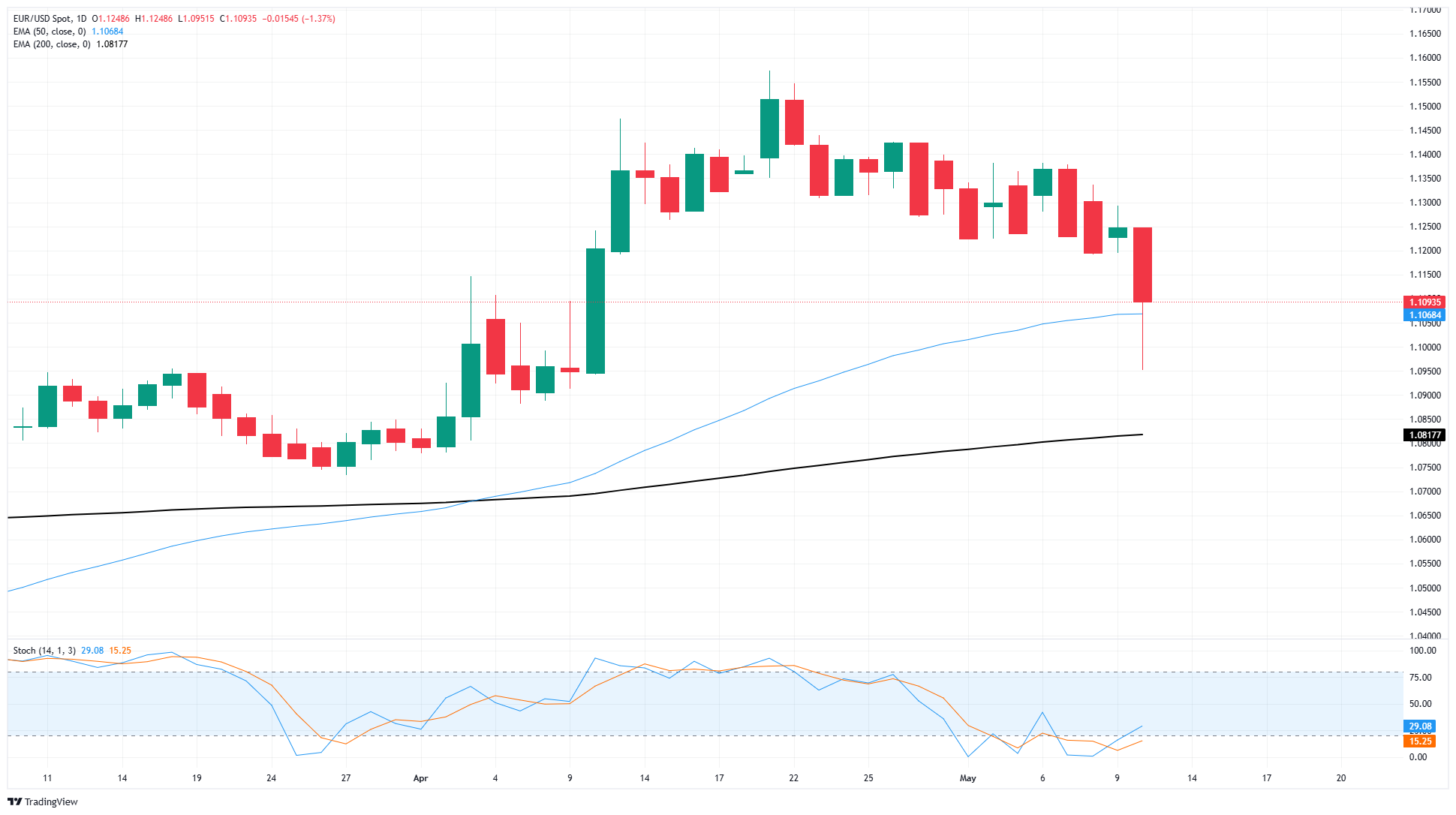EUR/USD takes a halting plunge, tests below 1.10 as key inflation data looms ahead
- EUR/USD took a tumble on Monday, closing 1.4% lower a brief test below 1.1000.
- A (temporary) walkback of US-China tariffs bolstered risk appetite.
- Key US CPI inflation data looms ahead, with EU GDP growth figures around the corner.
EUR/USD took a hard step lower on Monday, kicking off the new trading week with a fresh dip below 1.1000 before a late recovery pushed the pair back toward 1.1100. The Fiber still closed 1.4% lower on the day, and investors are bracing for a fresh batch of United States (US) Consumer Price Index (CPI) inflation data due on Tuesday.
Forex Today: All the attention shifts to US Inflation data
The US and China have jointly decided to pause steep triple-digit tariffs during initial trade discussions over the weekend, giving markets a brief respite before the US’s unusual “reciprocal” tariff schedule is set to resume in 90 days. The US Consumer Price Index (CPI) inflation report for April will be closely monitored this Tuesday. Headline CPI inflation is projected to rise to 0.3% month-over-month from the previous -0.1%, while core CPI inflation is anticipated to increase to 0.3% from 0.1%. Despite these monthly changes, both core and headline inflation are expected to remain stable YoY.
US CPI inflation, EU GDP growth on the docket this week
Final German Harmonized Index of Consumer Prices (HICP) inflation is due on Wednesday, but no major changes are expected in the non-preliminary data. Advance pan-European Gross Domestic Product (GDP) growth figures are slated for Thursday, and will be Euro traders’ big print for the week. Markets broadly expect both QoQ and annualized GDP growth to hold steady at previous figures of 0.4% and 1.2%, respectively.
EUR/USD price forecast
EUR/USD’s fresh bearish plunge on Monday saw the pair test below 1.1000 for the first time since early April. The pair is still trading north of the 50-day Exponential Moving Average (EMA) near 1.1070, but only just.
Price momentum has been firmly bearish since the pair peaked above 1.1500 and failed to hold the critical level. Daily candles have closed bearish more often than not for the last 14 consecutive trading sessions, or nearly three weeks.
EUR/USD daily chart

Euro FAQs
The Euro is the currency for the 19 European Union countries that belong to the Eurozone. It is the second most heavily traded currency in the world behind the US Dollar. In 2022, it accounted for 31% of all foreign exchange transactions, with an average daily turnover of over $2.2 trillion a day. EUR/USD is the most heavily traded currency pair in the world, accounting for an estimated 30% off all transactions, followed by EUR/JPY (4%), EUR/GBP (3%) and EUR/AUD (2%).
The European Central Bank (ECB) in Frankfurt, Germany, is the reserve bank for the Eurozone. The ECB sets interest rates and manages monetary policy. The ECB’s primary mandate is to maintain price stability, which means either controlling inflation or stimulating growth. Its primary tool is the raising or lowering of interest rates. Relatively high interest rates – or the expectation of higher rates – will usually benefit the Euro and vice versa. The ECB Governing Council makes monetary policy decisions at meetings held eight times a year. Decisions are made by heads of the Eurozone national banks and six permanent members, including the President of the ECB, Christine Lagarde.
Eurozone inflation data, measured by the Harmonized Index of Consumer Prices (HICP), is an important econometric for the Euro. If inflation rises more than expected, especially if above the ECB’s 2% target, it obliges the ECB to raise interest rates to bring it back under control. Relatively high interest rates compared to its counterparts will usually benefit the Euro, as it makes the region more attractive as a place for global investors to park their money.
Data releases gauge the health of the economy and can impact on the Euro. Indicators such as GDP, Manufacturing and Services PMIs, employment, and consumer sentiment surveys can all influence the direction of the single currency. A strong economy is good for the Euro. Not only does it attract more foreign investment but it may encourage the ECB to put up interest rates, which will directly strengthen the Euro. Otherwise, if economic data is weak, the Euro is likely to fall. Economic data for the four largest economies in the euro area (Germany, France, Italy and Spain) are especially significant, as they account for 75% of the Eurozone’s economy.
Another significant data release for the Euro is the Trade Balance. This indicator measures the difference between what a country earns from its exports and what it spends on imports over a given period. If a country produces highly sought after exports then its currency will gain in value purely from the extra demand created from foreign buyers seeking to purchase these goods. Therefore, a positive net Trade Balance strengthens a currency and vice versa for a negative balance.

